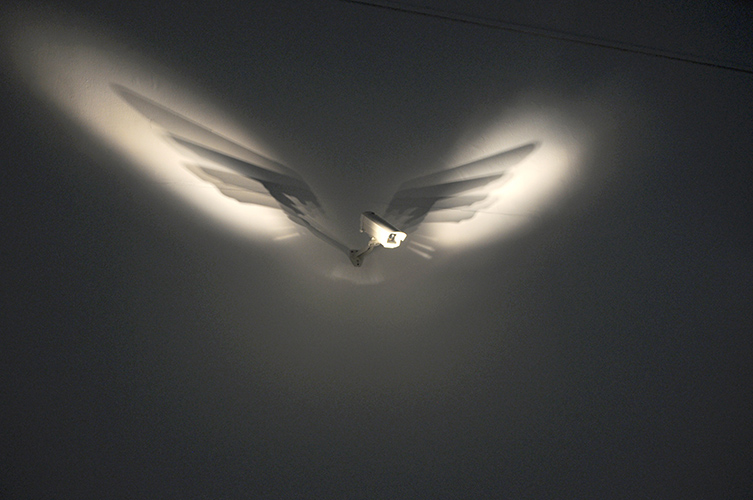* 1977 in Miskolc, HU, lives and works in Budapest, HU
Turul
2012, Light installation
A flying bird; its body is a surveillance camera, its wings are shadows. The drawing with light on the wall evokes a metaphysical feature of this surveillance tool. The title of the artwork supports this idea. Turul is not only a falcon; it is a divine creature in Hungarian mythology, the guide that led the wandering Hungarians to their later homeland.
Recently, however, the Turul has been usurped by nationalist radicals, who use historical and mythological motifs, like the horizontal red and white stripes from the coat of arms of the Árpád dynasty, to construct their interpretation of Hungarian identity.
“The powerful reappearance of the Turul bird in Hungary has become one of the key signifiers of the new national self-definition of the country’s right and far right. The symbol is rooted in mystical and romantic historiography, which is the main tool for constructing the current national identity and its historical mission in Europe and the world.”
Here the Turul is depicted as God’s eye with the surveillance camera, yet if we think how this symbol is being utilized at the moment, the work is revealed as criticizing this contemporary phenomenon of using and abusing figures from mythology and history by pressing them into the service of “national” representation. (Lívia Rózsás)

Ēriks Mātrai
1977, Miškolca, HU, dzīvo un strādā Budapeštā, HU
Turuls
Gaismas instalācija
2012
Lidojošs putns; tā ķermenis ir novērošanas kamera, tā spārni ir ēnas. Zīmējums ar gaismu uz sienas raisa metafizisku šī novērošanas instrumenta noskaņu. Mākslas darba nosaukums apstiprina šo ideju. Turuls ir ne tikai piekūns; tā ir dievišķa būtne ungāru mitoloģijā, pavadonis, kas aizveda klejojošos ungārus uz to vēlāko tēvzemi.
Tomēr pēdējā laikā Turuls uzurpējuši nacionālistu radikāļi, kuri izmanto vēsturiskus un mitoloģiskus motīvus, piemēram, horizontālās sarkanās un baltās svītras no Árpád dinastijas ģerboņa, lai veidotu savu interpretāciju par ungāru identitāti.
Šeit Turuls ir attēlots kā Dieva acs ar novērošanas kameru, tomēr, ja mēs domājam par to kā šis simbols tiek izmantots šobrīd, darbs atklājas kā kritika šai mūsdienu parādībai izmantot un sagrozīt tēlus no mitoloģijas un vēstures, uzspiežot tiem “nacionālā” pārstāvniecību.
Līvija Nolasko-Rožāsa